- Kids Preschool
- About Blocks ( 막기 makgi )
- Supported Downward Block ( 거들어 내려막기 kodureo-naeryeo-makgi )
Taekwondo 태권도Taekwondo Preschool
Promotion from one geup to the next can proceed rapidly in some schools, since schools often allow geup promotions every two, three, or four months. Students of geup rank learn the most basic techniques first, and then move on to more advanced techniques as they approach first dan. Many of the older and more traditional schools often take longer to allow students to test for higher ranks than newer, more contemporary schools, as they may not have the required testing intervals. View Taekwondo belt levels »

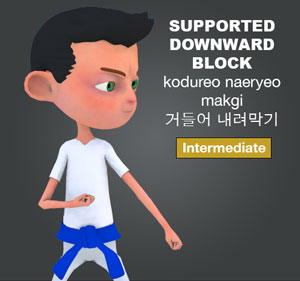
Supported Downward Block
( 거들어 내려막기 kodureo-naeryeo-makgi )
Difficulty Level: Intermediate Technique: Blocks ( 막기 makgi )
The Supported Downward Block ( 거들어 내려막기 kodureo-naeryeo-makgi ) has the practitioner making a low block ( 아래막기 arae-makgi ) with one hand ( 손 son ), while the other hand ( 손 son ) is supporting the block ( 막기 makgi ) with fists ( 주먹 jumeok ) around the sternum area. This advanced blocking technique is first introduced in World Taekwondo (WT) Taegeuk #8 태극 8장 Pal Jang Poomse.
The blocking hand ( 손 son ) starts from shoulder level with the palm ( 손바닥 sonbadak ) up while you stretch the other hand ( 손 son ) far from the waist reaching outwards with the palm ( 손바닥 sonbadak ) facing downward at shoulder height level. Both hands ( 손 son ) should be completed at the same time but not one after another when executing the block ( 막기 makgi ).
The supporting hand ( 손 son ) could be used as a counter strike such as with the Palm Heel Forward Strike ( 바탕손 앞치기 batangson-ap-chigi ), Spearhand Vertical Thrust ( 편손끝 세워찌르기 pyeonsonkkeut-sewo-jjireugi ), or the Flat Fingertips Horizontal Strike ( 편손끝 엎어찌르기 pyeonsonkkeut-eopeo-jjireugi ).
In the final form, the blocking arm's elbow ( 팔굽 palgup ) and the supporting hand ( 손 son ) should not be touching each other. The front blocking fist is set above the thigh roughly two-fist gap distance most commonly in a Back Stance ( 뒷굽이 dwi-kubi ). The supporting hand ( 손 son ) is placed one fist below the solar plexus with the wrist ( 팔목 palmok ) aligned to the center of body. Remember to keep the wrists ( 팔목 palmok ) straight.
* Please see a certified Master Instructor ( 사범님 sabeomnim ) for training. Proper guidance and instructions are needed to ensure safe training.


Did you know?
Impact Surface Area
Various surfaces of the body may be engaged as the blocking and striking surface depending on which area of the body is being targeted. This leads to a large array of blocking and striking positions. More information on Impact Surface Areas »
| Surface | Korean | Description | Tutorial | |
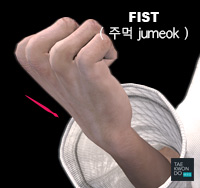 |
Fist ( 주먹 jumeok ) - is an action where a hand has the fingers curled into the palm and the thumb retracted, displaying the knuckles. |
주먹 jumeok | A fist ( 주먹 jumeok ) is an action where a hand has the fingers curled into the palm and the thumb retracted, displaying the knuckles. The act of creating a fist is known as 'making a fist' or 'clenching a fist'. | Tutorial » |
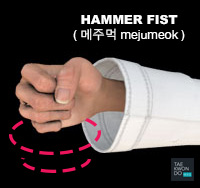 |
Hammer Fist ( 메주먹 mejumeok ) - is an action where a hand has the fingers curled into the palm and the thumb retracted, using the bottom of the hand as the striking surface. |
메주먹 mejumeok | A Hammer Fist is an action where a hand has the fingers curled into the palm and the thumb retracted, using the bottom of the hand as the striking surface. The act of creating a fist ( 주먹 jumeok ) is known as 'making a fist' or 'clenching a fist'. | Tutorial » |
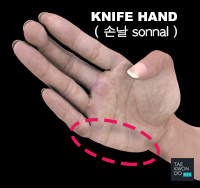 |
Hand Blade ( 손날 sonnal ) - striking surface extends with the muscle at the side of the hand located between the base of the small finger and the wrist. |
손날 sonnal | By tucking the thumb into the palm, a striking surface called the knife hand or hand blade ( 손날 sonnal ) is formed. The striking surface extends with the muscle at the side of the hand located between the base of the small finger and the wrist. | Tutorial » |
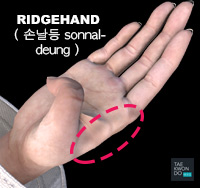 |
Ridgehand ( 손날등 sonnal-deung ) - reverse knife-hand is formed, extending a few inches along the inside of the hand below the first knuckle of the index finger. |
손날등 sonnal-deung | By tucking the thumb into the palm, a striking surface called the ridgehand ( 손날등 sonnal-deung ), or reverse knife-hand is formed, extending a few inches along the inside of the hand below the first knuckle of the index finger. | Tutorial » |
RESOURCES
This article uses material from the Wikipedia articles "Hand", "Fist (hand)", "Knife Hand", which is released under the Creative Commons Attribution-Share-Alike License 3.0.

Quiz
Question. In what year was Kukkiwon ( 국기원 ) being officially named on?
Kukkiwon ( 국기원 ), also known as World Taekwondo Headquarters, and home of the World Taekwondo Academy, is the official taekwondo governing organization established by the South Korean government. It is supervised by the International Sports Division of the Ministry of Culture, Sports, and Tourism. Kukkiwon is based at 635 Yeoksam-dong ( 역삼동 ) in the Gangnam-gu ( 강남구 ) district of Seoul, South Korea.
Question. In what year was Kukkiwon ( 국기원 ) being officially named on?
Answer you gave was: 1971
Your answer is wrong! You need to study more!

The organization being officially named on 6 February 1973. Known as World Taekwondo Headquarters, is the official taekwondo governing organization established by the South Korean government. Although the terms "WT" and "Kukkiwon" are often mistakenly used interchangeably, the Kukkiwon is a completely different organization which trains and certifies instructors and issues official dan and poom certificates worldwide.
View Kukkiwon ( 국기원 ) » 
Question. In what year was Kukkiwon ( 국기원 ) being officially named on?
Answer you gave was: 1973
Your answer is correct! Great Job!

The organization being officially named on 6 February 1973. Known as World Taekwondo Headquarters, is the official taekwondo governing organization established by the South Korean government. Although the terms "WT" and "Kukkiwon" are often mistakenly used interchangeably, the Kukkiwon is a completely different organization which trains and certifies instructors and issues official dan and poom certificates worldwide.
View Kukkiwon ( 국기원 ) » 
Question. In what year was Kukkiwon ( 국기원 ) being officially named on?
Answer you gave was: 1975
Your answer is wrong! You need to study more!

The organization being officially named on 6 February 1973. Known as World Taekwondo Headquarters, is the official taekwondo governing organization established by the South Korean government. Although the terms "WT" and "Kukkiwon" are often mistakenly used interchangeably, the Kukkiwon is a completely different organization which trains and certifies instructors and issues official dan and poom certificates worldwide.
View Kukkiwon ( 국기원 ) » 
Question. In what year was Kukkiwon ( 국기원 ) being officially named on?
Answer you gave was: 1977
Your answer is wrong! You need to study more!

The organization being officially named on 6 February 1973. Known as World Taekwondo Headquarters, is the official taekwondo governing organization established by the South Korean government. Although the terms "WT" and "Kukkiwon" are often mistakenly used interchangeably, the Kukkiwon is a completely different organization which trains and certifies instructors and issues official dan and poom certificates worldwide.
View Kukkiwon ( 국기원 ) » 
Question. What is the name of Taegeuk #5 in Korean?
Taegeuk 태극 (in World Taekwondo (WT)) refers to a set of poomse 품새 used to create a foundation for the teaching of taekwondo. A poomse or form is a detailed pattern of defense-and-attack motions and techniques used in traditional martial arts. Each taegeuk form symbolizes a specific state thought to be indicative of the belt the student currently holds, and is represented in World Taekwondo (WT) by trigrams similar to those found in the four corners of the South Korean flag.
Question. What is the name of Taegeuk #5 in Korean?
Answer you gave was: Sam Jang
Your answer is wrong! You need to study more!


This trigram represents Fire. Related to this symbol is also East and the relationship of the Second Daughter. Fire contains a lot of energy. The symbol behind the fire is similar to the symbolism of the water in that both can aid and both can destroy. This form is intended to be performed rhythmically, with some outbursts of energy to reflect fire's rhythmic and energetic dualism.
Question. What is the name of Taegeuk #5 in Korean?
Answer you gave was: Yi Jang
Your answer is wrong! You need to study more!
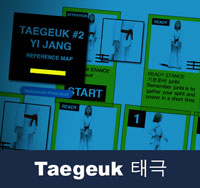

The associated trigram of this poomse represents the Lake. Also, related to the symbol is South East and the relationship of the youngest daughter. The movements of this Taegeuk are aimed to be performed believing that man has limitations, but that we can overcome these limitations. The Lake and its water symbolize the flowing and calm nature of the martial artist.
Question. What is the name of Taegeuk #5 in Korean?
Answer you gave was: Yuk Jang
Your answer is wrong! You need to study more!


The trigram associated with this poomse represents Water. Also, there is a relation to West and the relationship with a Second son. The movements of this poomse are intended to be performed like water; flowing, powerful and cleansing. Sometimes standing still like water in a lake, sometimes thriving as a river, sometimes powerful like a waterfall.
Question. What is the name of Taegeuk #5 in Korean?
Answer you gave was: O Jang
Your answer is correct! Great Job!
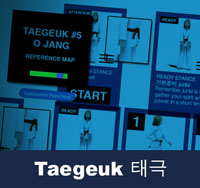

The trigram associated with this poomse represents Wind. The trigram is also related to southwest and the relationship with an eldest daughter. The I Ching promotes that wind is a gentle force, but can sometimes be furious, destroying everything in its path. As such, it is intended that this poomse is performed like the wind: gently, but knowing the ability of mass destruction with a single movement.
Question. What is the korean terminology for Kicking?
A kick is a physical strike using the foot, leg, or knee. As the human leg is longer and stronger than the arm, kicks are generally used to keep an opponent at a distance, surprise him or her with their range, and inflict substantial damage. All kicks can be executed as jump kicks, spin kicks, jump spin kicks or multi-rotational spin kicks. Also, all can be performed by the front or rear leg in a given stance.
Question. What is the korean terminology for kicking?
Answer you gave was: ( 차기 chagi )
Your answer is correct! Great Job!
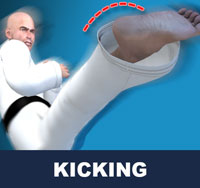

Kicking ( 차기 chagi ) is a physical strike using the foot ( 발 bal ), leg, or knee ( 무릎 mureup ). As the human leg is longer and stronger than the arm ( 팔 pal ), kicks ( 차기 chagi ) are generally used to keep an opponent at a distance, surprise him or her with their range, and inflict substantial damage. Any attempt to deliver a kick ( 차기 chagi ) will necessarily compromise one's stability of stance ( 서기 sogi ).
Question. What is the korean terminology for kicking?
Answer you gave was: ( 서기 sogi )
Your answer is wrong! You need to study more!
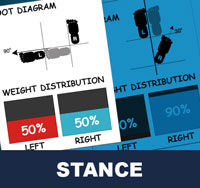

The Korean martial arts has several Stances ( 서기 sogi ) used for different activities. Although there are strong similarities in stances throughout taekwondo schools, individual instructors often have their own preferred style. These stances are most commonly seen in taekwondo forms, and are critical for balance, precision, and good technique in the martial art.
Question. What is the korean terminology for kicking?
Answer you gave was: ( 막기 makgi )
Your answer is wrong! You need to study more!
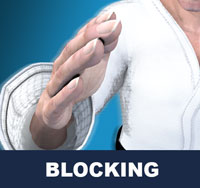

In martial arts, blocking ( 막기 makgi ) is the act of stopping or deflecting an opponent's attack for the purpose of preventing injurious contact with the body. A block ( 막기 makgi ) usually consists of placing a limb across the line of the attack. Blocks ( 막기 makgi ) are considered by some to be the most direct and least subtle of defensive techniques.
Question. What is the korean terminology for kicking?
Answer you gave was: ( 치기 chigi )
Your answer is wrong! You need to study more!
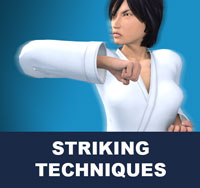

Taekwondo Strikes ( 치기 chigi ) are performed as a close distance alternative to kicks. Hand strikes make up fast combinations of strikes which can leave an opponent stunned and unable to defend himself. Striking ( 치기 chigi ) are taekwondo techniques striking with the twisting force of the body excluding techniques using the fist ( 주먹 jumeok ) or fingertips ( 손끝 sonkkeut ).
There are five tenets defined in the International Taekwondo Federation (ITF) and several more in World Taekwondo (WT).
Integrity ( Yeom Chi / 염치 ): "Although it may be similar, this form of integrity takes on a more wider role then defined in the common dictionary. In taekwondo, integrity means not only to determine what is right or wrong but also having the conscience to feel guilt if one has done wrong and to have the integrity stand up for what is right." View Taekwondo Tenets »
RESOURCES
This article uses material from the Wikipedia article "List of Taekwondo Techniques", which is released under the Creative Commons Attribution-Share-Alike License 3.0.








